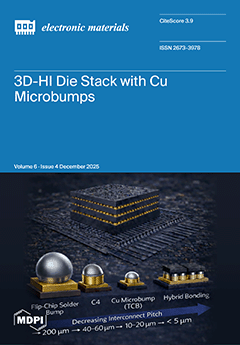Multiferroic composites of
xNi
0.8Zn
0.2Fe
2O
4/(1 −
x)BaTiO
3 (
x = 0, 0.1, 0.3, 0.5, labeled NZFO/BTO) with ~100 nm particle size were synthesized via high-energy ball milling and thermal annealing. The X-ray diffraction
[...] Read more.
Multiferroic composites of
xNi
0.8Zn
0.2Fe
2O
4/(1 −
x)BaTiO
3 (
x = 0, 0.1, 0.3, 0.5, labeled NZFO/BTO) with ~100 nm particle size were synthesized via high-energy ball milling and thermal annealing. The X-ray diffraction shows a co-existence of the ferromagnetic phase of NZFO and the ferroelectric phase of BTO. Our observations indicate that saturation, remanence, and coercivity progressively increase with increasing NFO content, specifically from
x = 0 to
x = 0.5. At
x = 0.1, the maximum electric polarization, remanent electric polarization, coercivity and electric power loss density reach their maximum values of ~0.057
µC/cm
2, 0.018
µC/cm
2, 3.25 kV/cm and 0.222 mJ/cm
3, respectively, for an applied electric field less than 10 kV/cm. These multiferroic composites demonstrate excellent electromagnetic wave absorption capabilities from 2 to 18 GHz. With BTNF1 (
x = 0.1) sample thickness of 2.5–3.5 mm, a minimum reflection loss of −41.51, −37, −28.72 dB corresponds to frequencies of 12.52 GHz, 11 GHz and 9.32 GHz. The effective absorption bandwidth for this sample is 11.5–16 GHz, indicating optimal impedance and attenuation matching and effective absorption of electromagnetic waves throughout the K
u bands. These outcomes reveal the capability for wideband absorption uses in radar invisibility technology and electromagnetic insulation.
Full article




